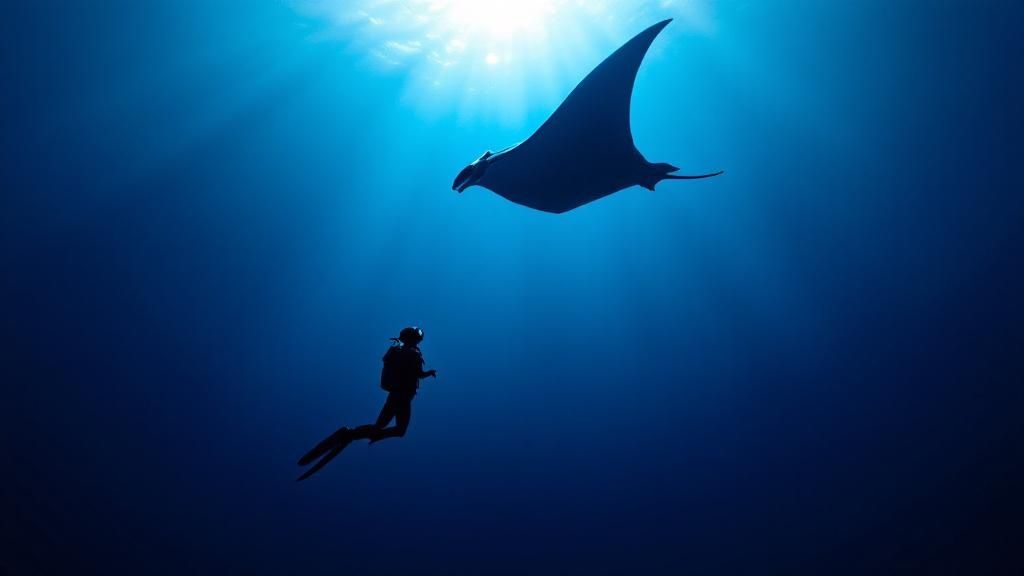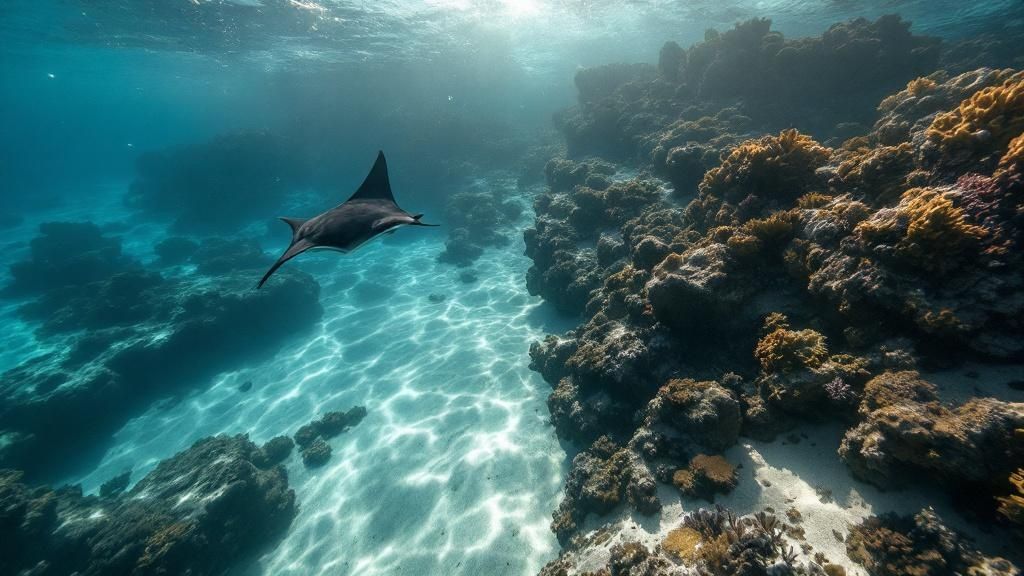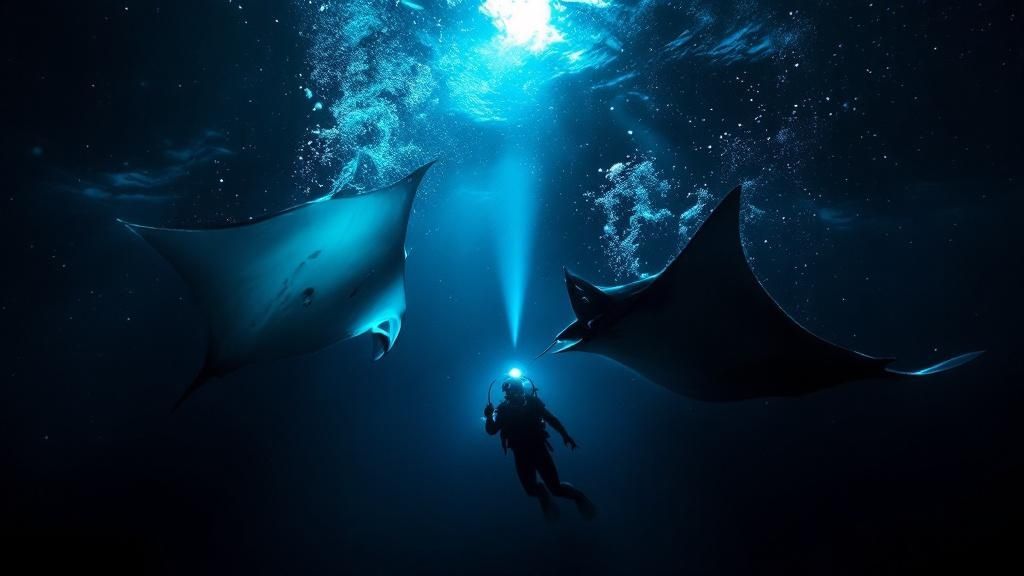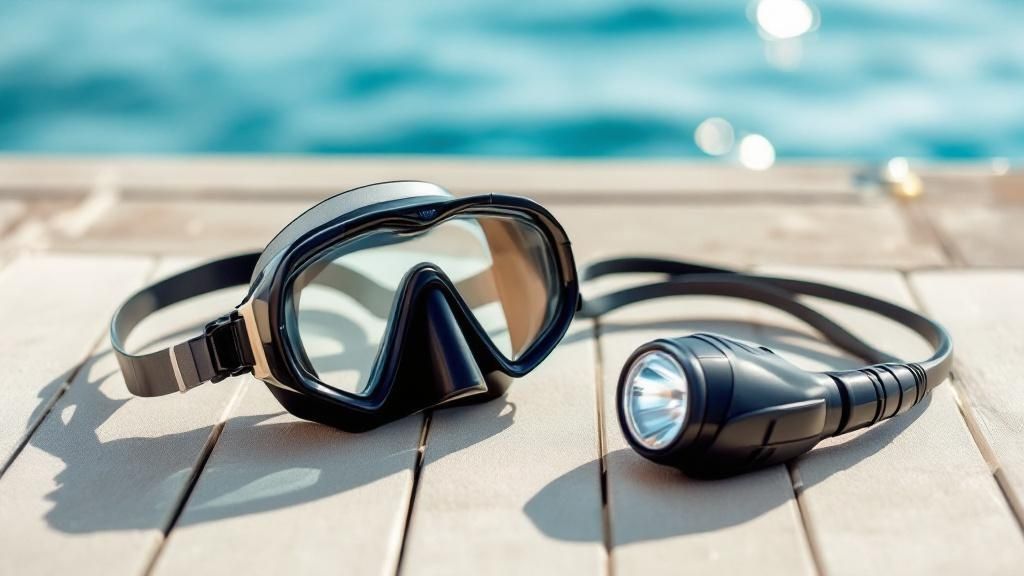The Kona manta ray dive is, without a doubt, one of the most phenomenal underwater encounters you can have anywhere on the planet. It's famous for good reason—it’s reliable, it’s beautiful, and it feels like stepping into another world. Picture this: a silent, underwater ballet where enormous, graceful creatures with wingspans reaching up to 18 feet glide through columns of light. This is the magic that awaits you.
Your Guide to the Kona Manta Ray Dive

Welcome to one of the world's most breathtaking adventures. For divers and snorkelers, the Kona coast of the Big Island is a true pilgrimage site, drawing people from all over the globe to witness its famous manta rays. But what makes this experience so consistently amazing? It’s a happy accident, a perfect storm of biology, geography, and a little human ingenuity.
The whole thing works because of plankton. Manta rays are filter feeders, and their favorite meal, zooplankton, is naturally drawn to light. The story goes that decades ago, a hotel on the coast started leaving its lights on, which attracted swarms of plankton. The mantas weren't far behind. Dive operators realized what was happening and started recreating the effect on purpose, shining powerful lights into the water to create a dependable, all-you-can-eat plankton buffet. The mantas have been showing up for dinner ever since.
Manta Village vs. Manta Heaven
When you start planning your Kona manta ray dive, you’ll quickly hear about two main locations. Each offers a slightly different flavor of the same incredible experience, and picking the right one often comes down to your comfort in the water and what kind of night you’re looking for.
Manta Village vs Manta Heaven At a Glance
This table breaks down the key differences between the two premier manta ray sites in Kona, helping you decide which is the best fit for you.
| Feature | Manta Village (Keauhou Bay) | Manta Heaven (Kona Airport) |
|---|---|---|
| Location | South of Kona, in Keauhou Bay | North of Kona, near the airport |
| Depth | 25-35 feet | 35-45 feet |
| Conditions | Generally calmer, more protected | Can have stronger currents & surge |
| Best For | Beginner divers, snorkelers, families | Experienced divers |
| Crowd Size | Can be very busy, but well-managed | Often has fewer boats/people |
| Manta Sightings | Highly consistent and reliable | Very reliable, sometimes more mantas |
Both sites offer an incredible show, but your experience will be best if you choose the one that matches your skill and comfort level.
Manta Village (Keauhou Bay)
This is the original, the classic, the most famous site. Located in the relatively calm and shallow waters of Keauhou Bay, Manta Village is absolutely perfect for first-timers, nervous divers, and even snorkelers. The conditions are usually more predictable here, making it a fantastic and low-stress introduction to the world of manta rays.
Manta Heaven (Kona Airport)
A bit further north near the airport, Manta Heaven is often the preferred spot for more seasoned divers. The site can be deeper and is more exposed, meaning you might encounter stronger currents. The payoff? Sometimes, this site hosts an even larger congregation of mantas, creating a truly epic spectacle for those with the skills to handle the more dynamic conditions.
The core idea behind the dive is passive observation. You become part of the scenery. Divers and snorkelers form a circle of light on the ocean floor or the surface, creating an irresistible "campfire" that draws in the plankton and invites the mantas to their nightly feast.
This unique setup has cemented Kona's reputation as a world-class destination for marine wildlife. It's a massive draw for the island—every year, around 80,000 people come to see the mantas, and you can learn more about the history of these iconic dive sites to appreciate how it all began.
Whether you opt for the protected waters of Manta Village or the wilder currents of Manta Heaven, you're signing up for a night you’ll never forget. This guide will walk you through everything you need to know to make your Kona manta ray dive dream a reality.
Understanding Kona's Gentle Giants

To really get the most out of a manta ray dive in Kona, it helps to know a little about the stars of the show. These aren't just fish; they're intelligent, social, and truly magnificent creatures. The mantas you'll meet are reef manta rays, known scientifically as Mobula alfredi.
They're the second-largest ray species on the planet, with incredible wingspans that can stretch up to 18 feet. Most of the regulars in Kona are a still-massive 12 feet across.
Don't let their size fool you; they are completely harmless. Unlike their stingray cousins, manta rays don't have a stinger. The only thing they're interested in is their next meal, and that’s the secret behind this whole amazing experience.
The Underwater Buffet
The entire dive is essentially a perfectly orchestrated dinner party for mantas. Your dive lights play a crucial role, acting like a giant neon sign that says, "All-you-can-eat buffet here!"
Here's how it works:
- Tiny, microscopic organisms called zooplankton are naturally drawn to light.
- The powerful dive lights create a thick, concentrated cloud of this plankton.
- The mantas, being incredibly smart, figured this out a long time ago. They know that where the lights go, an easy meal follows.
This learned behavior is what makes the Kona manta ray dive so consistently spectacular. They show up night after night to feast, performing an "underwater ballet" as they glide, swoop, and somersault through the light beams with their huge mouths open. It’s this incredible spectacle that makes the dive so unforgettable. If you're still on the fence, you can learn more about why you should go on a manta ray dive in Kona.
A Manta's Fingerprint: Each manta ray has a completely unique pattern of black spots on its white belly. Just like a human fingerprint, this pattern allows researchers—and even you—to tell individual animals apart.
This beautiful, symbiotic relationship has become a pillar of Kona's tourism and marine research efforts. Dive operators and researchers have been keeping detailed records for years, creating an impressive database of the local manta population. This long-term data provides priceless insights into their health, migration patterns, and social behaviors, proving just how vital these dive sites are.
When you go on this dive, you're not just a tourist. You're part of a legacy of observation and appreciation for these gentle giants.
Planning Your Manta Ray Adventure

Logistics can make or break any trip, and a little forethought goes a long way. When you're planning your manta ray dive in Kona, a few key details will shape the entire experience, from the time of year you book your flight to the specific type of tour you choose.
One of the first questions people ask is when to go. The fantastic news is that Kona's manta rays are here year-round, so there’s technically no "off-season." That said, if you're looking for the absolute best conditions, aim for late spring through early fall (April to October). The ocean is typically flatter than a lake, and the water clarity is often incredible. While winter diving is still great, it can bring bigger swells, which sometimes lead to tour cancellations.
Twilight vs. Night Dive Options
When you start looking at booking, you'll likely see two main choices: a twilight (or sunset) dive and a standard night dive. Knowing the difference is key to picking the perfect trip for you.
| Tour Type | Key Feature | Best For |
|---|---|---|
| Twilight/Sunset Dive | A two-tank charter that includes a reef dive before the manta dive. | Divers who want to see the reef transform from day to night. |
| Standard Night Dive | A single-tank dive focused solely on the manta ray experience after dark. | Divers short on time or those who just want to get straight to the main event. |
Think of the twilight trip as a double feature. You’ll do your first dive in the late afternoon, exploring the beautiful coral reef as the light starts to fade. You then get back on the boat for a surface interval with a stunning sunset view before gearing up for round two with the mantas. The standard night dive is more direct—a one-tank trip that heads straight to the manta site after the sun has gone down.
What's Typically Included? Reputable operators will have you covered. Expect all your scuba gear—tanks, weights, a wetsuit, and dive lights—to be included. You’ll also get a comprehensive safety briefing, professional in-water guides, and usually some snacks and drinks on board.
Your Pre-Dive Briefing
Before a single fin hits the water, your divemaster will gather everyone for a thorough briefing. Don't tune this part out; it's absolutely essential. They'll walk you through the dive site layout, the plan for getting everyone in and out of the water, and most importantly, the rules for interacting with the mantas safely and respectfully.
This briefing is all about making sure both divers and mantas have a good, safe experience. You'll learn exactly where to position yourself on the bottom, how to aim your light to attract plankton, and why passive observation is non-negotiable. If you want a play-by-play of what a charter feels like, check out this great overview of a manta ray night dive in Kailua-Kona. Showing up prepared and knowing what to expect is the first step to an adventure you’ll never forget.
How to Choose the Right Manta Ray Tour

A quick search for a manta ray dive in Kona brings up a ton of companies, and it can be tough to know who to trust with your adventure. Let’s be clear: picking the right operator is the single most important decision you'll make. It’s the difference between a truly magical, safe experience and one that’s just… okay.
The best outfits in Kona aren't just running a business; they're stewards of this incredible natural wonder. They live and breathe manta conservation. This commitment shows in their impeccable safety protocols, smaller group sizes, and deep respect for the animals.
Big Boat vs. Small Charter
Your first big decision is whether to go with a large, cattle-call-style boat or a smaller, more intimate charter. There are pros and cons to each, and the right choice really boils down to your personal preference.
-
Large Operators: These boats are often bigger and more stable, which is a huge plus if you get seasick easily. They run like a well-oiled machine, usually with more amenities on board. The experience is reliable and predictable.
-
Small Charters: This is where you get a more personal touch. Fewer people in the water means a less crowded, more relaxed dive. You'll likely get more one-on-one attention from your guide, creating a much more intimate feel.
Think of it this way: a big boat is like a stadium concert—exciting and high-energy. A small charter is more like an acoustic set in a small venue—up close and personal. Neither is better than the other, just different.
Questions to Ask Before You Book
Don't be shy about asking some tough questions before you pull out your wallet. A good, honest company will have no problem answering them. Being an informed customer is the best way to avoid a bad time.
Here’s what you need to ask:
- Safety First: What’s your safety record? What is your guide-to-guest ratio? This should always be your first question.
- Eco-Consciousness: Do you follow the Manta Ray Green List guidelines? Are your interactions strictly passive? You want an operator who puts the mantas' well-being first.
- The "Manta Guarantee": Sightings are incredibly reliable, with a 90%+ success rate. But what happens on that rare night they don't show? Ask about their policy.
- All-Inclusive or A La Carte?: What’s included in the price? Confirm if wetsuits, dive gear, and lights are part of the deal to avoid any surprise charges at the dock.
The best operators book up fast, especially during peak seasons, so it pays to plan ahead. To get an even more detailed breakdown, check out this complete guide to the manta ray dive kona experience. Choosing wisely ensures your night with the mantas will be unforgettable for all the right reasons.
Essential Rules for a Safe and Respectful Dive
How you act in the water during a manta ray dive in Kona is the most critical part of keeping the experience safe and incredible for everyone—including the mantas. The whole philosophy boils down to one simple idea: passive observation. You're a guest in their underwater dining room, so the best thing you can do is be a polite, quiet spectator.
Think of it like being at a fantastic movie in a massive theater. You wouldn't just stand up and walk in front of the screen, would you? The same idea applies here. The mantas need that open water column to do their thing, swooping and gliding with incredible grace. By staying put, you make sure you don't get in their way or cause an accidental collision.
The Campfire and Buoyancy Control
When you get down there, your dive guide will set up a powerful light source on the ocean floor. We call this the "campfire." This light is what draws in the plankton, and the plankton, in turn, brings the mantas right to us. Your job is simple: find a spot on the sandy bottom around this campfire and make it your home for the dive.
This is where solid buoyancy control is non-negotiable. You absolutely have to avoid kneeling on or touching the coral reef. This ecosystem is surprisingly fragile, and one careless fin kick can wipe out years of delicate coral growth. Staying neutrally buoyant and keeping low to the sand is how we protect this precious environment.
Rules of Engagement
To keep both divers and mantas safe, and to ensure the long-term health of Kona's manta population, all operators follow a strict set of rules. You can think of them as the official "house rules" for visiting the mantas' home.
- Observe Only, Never Touch: This is the golden rule. Manta rays have a protective mucus layer that acts as a shield against infection. If you touch them, you can rub off that coating, leaving them vulnerable to nasty diseases.
- Stay in Your Zone: Divers belong on or very near the bottom. Snorkelers stay on the surface. This creates a wide-open "stage" in the middle of the water column where the mantas can feed without anyone getting in their way.
- No Chasing or Riding: Never, ever chase, pursue, or try to ride a manta. Let them come to you if they choose.
- Avoid Sudden Movements: Quick, jerky motions or loud noises can easily spook these gentle giants. Move slowly and deliberately.
These guidelines are much more than just suggestions; they are vital for the future of this world-class encounter. The manta ray night dive industry is a huge deal for the local economy, bringing in over $2.5 million in annual revenue for the Kona community. It's a perfect example of how sustainable tourism and conservation can work hand-in-hand. This is exactly why Hawaii passed legislation back in 2009 making it illegal to harm or capture manta rays.
The goal is for the mantas to not even know you're there. By becoming part of the scenery, you allow them to behave naturally, giving you an authentic and breathtaking view of one of nature's most spectacular ballets.
Following these rules isn't just about checking a box; it's about showing respect. You're part of a system that has been carefully balanced for decades, weighing human observation against animal welfare. For a deeper dive into the ongoing efforts to formalize these interactions, you can read an open letter to the Hawaii DLNR regarding manta rules. By being a responsible diver, you're doing your part to make sure this mind-blowing experience will be around for generations to come.
Your Kona Manta Ray Dive Questions Answered
Even after doing your homework, it’s completely normal to have some last-minute questions before booking an adventure as unique as the manta ray dive in Kona. This section is all about tackling those common queries with clear, practical answers. Think of it as the final piece of the puzzle, giving you the confidence you need to take the plunge.
We'll clear up everything from whether you need a dive certification to what happens on the rare night the mantas decide to be shy. Let's get into it.
Do I Need to Be Scuba Certified to See Manta Rays?
Not at all! This is honestly one of the best things about the Kona manta experience—it’s designed for just about everyone. While certified divers get an amazing view from the seafloor, snorkelers get an equally mind-blowing, front-row seat right at the surface.
Most operators run their snorkel and dive tours in the same spot, at the same time. For snorkelers, the setup is simple but ingenious:
- You’ll hold onto a large, custom-built float or raft.
- This raft has powerful lights that point straight down into the dark water.
- The light attracts a buffet of plankton, and the mantas swim right up to the surface to feed.
You’ll see them glide, swoop, and do barrel rolls just inches beneath you. It’s an absolutely stunning perspective that requires zero scuba experience, which makes it a fantastic option for families or groups with different comfort levels in the water.
Is the Manta Ray Dive Safe for New Divers?
Yes, the manta ray dive can be an excellent and safe choice for newly certified divers, especially at the primary site known as Manta Village. Tucked into Keauhou Bay, this spot is naturally protected from open ocean swell, so conditions are almost always calm. The dive itself is also quite shallow, typically staying between 25 to 40 feet.
What really makes it great for beginners is the format of the dive. You simply descend with your guide to a designated spot on the sandy bottom. Once you’re there, you just kneel or sit and watch the show. There's no complicated navigating or tricky buoyancy control needed. This lets you relax and just soak in the incredible spectacle happening all around you.
Pro Tip: When you book, be honest about your experience level. A good operator will appreciate the heads-up and will make sure you feel completely comfortable and safe, from the moment you gear up to when you're back on the boat.
What if No Manta Rays Appear on My Tour?
While manta sightings in Kona are incredibly reliable—we're talking success rates well over 90%—it’s important to remember these are wild animals in their natural habitat. Their attendance can never be a 100% guarantee.
This is where reputable tour operators really shine. They understand the unpredictability of nature and almost always offer what’s known as a "manta guarantee." It's their promise that you won't go home disappointed.
The policy is usually straightforward: if your tour doesn't encounter any mantas, you can come back and try again for free on another tour (on a space-available basis). It's a sign of a company that's confident in their operation and it gives you great peace of mind. To be safe, always confirm the specific policy before you book and try to schedule your manta dive early in your vacation, just in case you need to use that second chance.
What Camera Gear Works Best for Manta Photos?
Photographing the manta ray night dive is an awesome challenge, but the low light and constant motion demand the right equipment and technique. A camera that performs well in low light, like a newer mirrorless or DSLR, paired with a wide-angle lens is the best place to start.
Here are a few essential tips to get you going:
- Ditch the On-Camera Flash: Firing your camera's built-in flash is a surefire way to get "backscatter." This is when the flash illuminates all the tiny particles floating in the water, making your photo look like it was taken in a snowstorm.
- Use External Lights: The secret to clean, dramatic underwater shots is using off-camera video lights or strobes. They cast a much more flattering light on the mantas and help them pop from the dark background.
- Start with These Settings: As a baseline, try a high ISO (around 1600-3200), a wide-open aperture (like f/2.8), and a shutter speed of about 1/80th of a second to help freeze the motion.
Above all, remember to be a considerate photographer. Never let your gear or your quest for the perfect shot get in the way of the experience for other people or disturb the mantas' natural behavior. For a deeper dive into the magic of this encounter, you can read more about what to know about the manta ray dive in Kona.
Ready to witness this unforgettable underwater ballet for yourself? At Kona Honu Divers, we blend world-class safety with a genuine passion for marine conservation to deliver the ultimate manta ray adventure. Book your dive or snorkel tour with us today and prepare to be amazed
